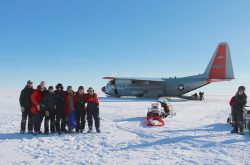
Antarctica’s next deep ice core, drilling down to ice from 130,000 years ago, will be carried out by a multi-institutional U.S. team at Hercules Dome, a location hundreds of miles from today’s coastline and a promising site to provide key evidence about the possible last collapse of the West Antarctic Ice Sheet.
The National Science Foundation has funded the roughly five-year, $3 million project involving the University of Washington, the University of New Hampshire, the University of California, Irvine and the University of Minnesota. Work has been delayed by the novel coronavirus, but drilling the 1.5-mile ice core likely will begin in 2024.
“The ice at this site goes back to a time when sea level was about 6 meters (20 feet) higher than it is now,” said project leader Eric Steig, a UW professor of Earth and space sciences. “One of the most likely reasons that sea level was higher is that a large area of Antarctic, known as the West Antarctic Ice Sheet, was gone.”
Scientists hope to understand the most recent collapse of the West Antarctic Ice Sheet in order to better gauge its potential risk in today’s warming climate. Deeper ice layers at this site reach back to Eemian times — the most recent period that, like now, was between ice ages. The Eemian was even warmer than today’s climate and oceans were higher.
Read more at UW News »
